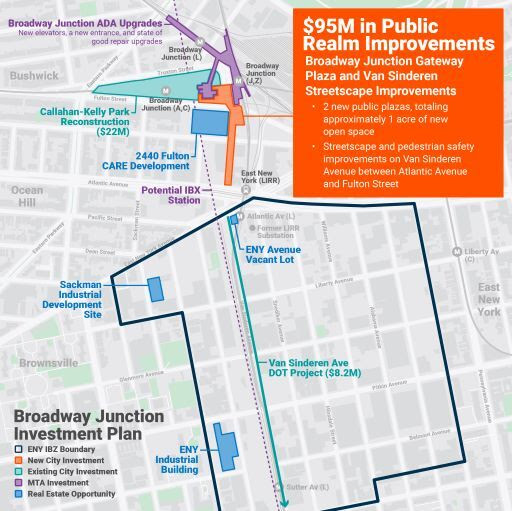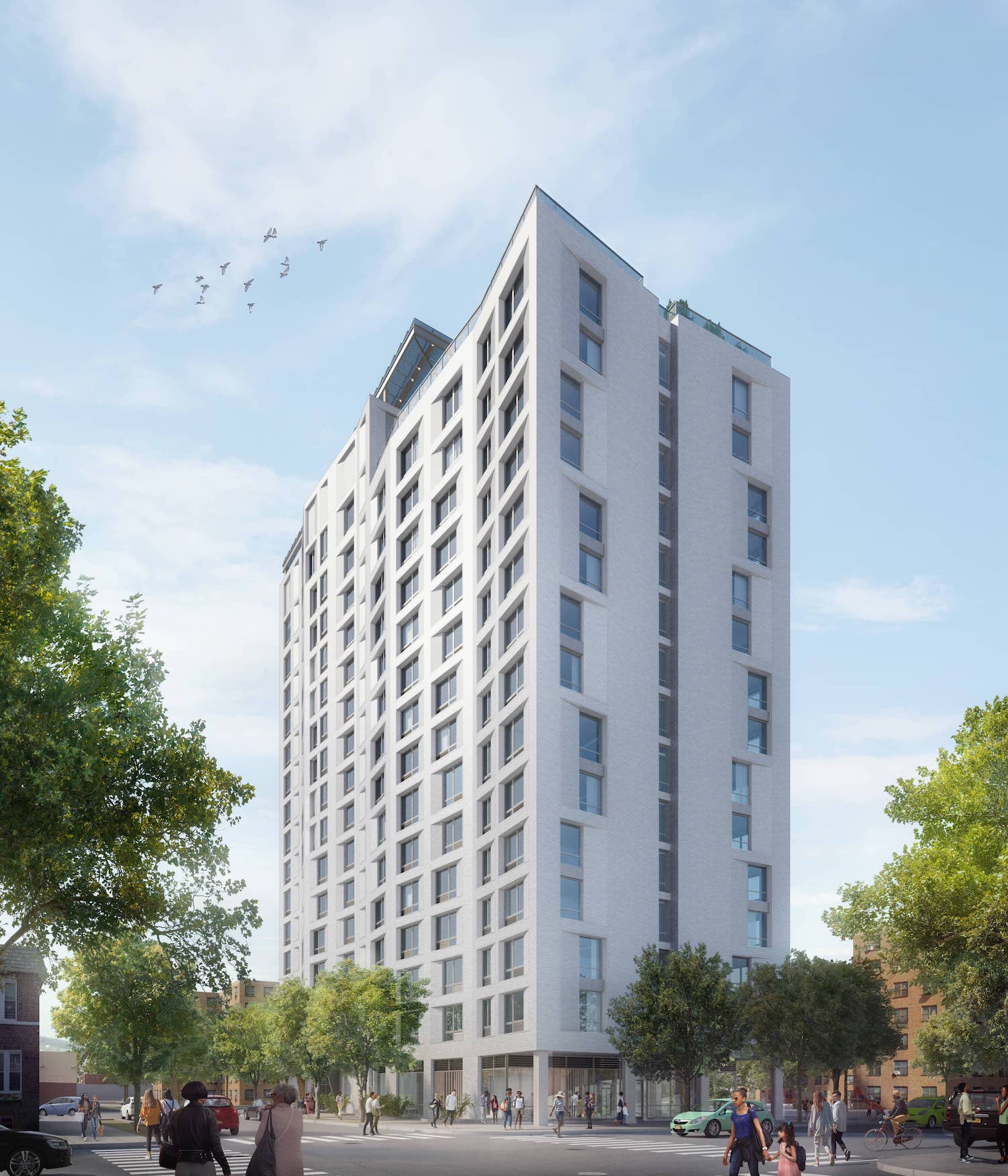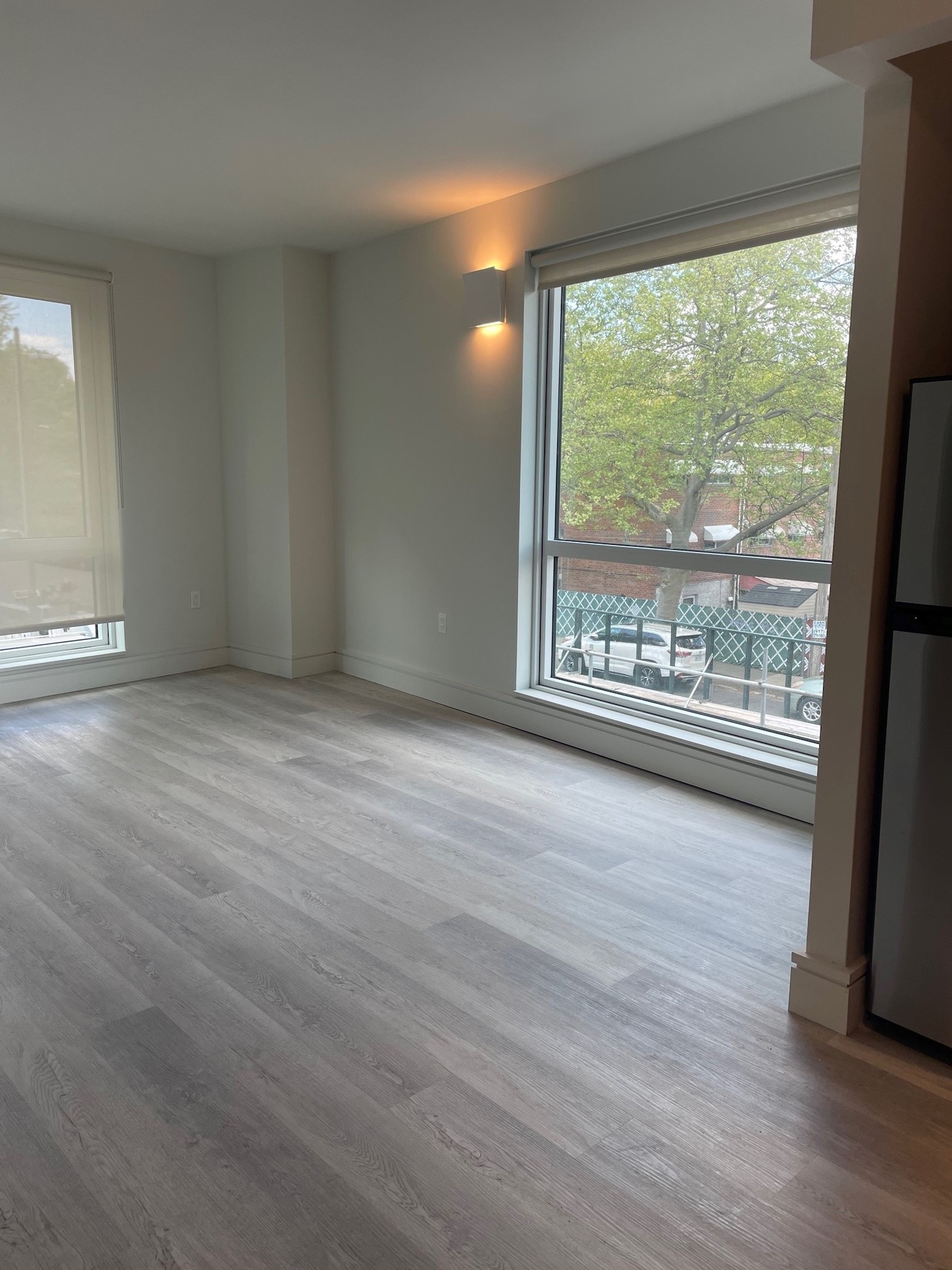NYCEDC and MTA to Oversee Nearly $500 Million in Public Realm Improvements, Station Complex Improvements, and Accessibility Upgrades
Public and Private Investments to Generate $11.6 Billion in Economic Impact and Over 2,300 Jobs, With City and State Prioritizing Local Hiring
New York City Mayor Eric Adams today announced a major public investment in the area around the Broadway Junction subway station in Brooklyn that will deliver vibrant public space, improve quality of life, create family-sustaining jobs, and unlock inclusive economic growth throughout East New York. Driving the plan is a $500 million public investment in the community, including $400 million from the Metropolitan Transportation Authority (MTA) for accessibility upgrades at the Broadway Junction station complex, part of ongoing efforts to make the station a true regional transit center. The remainder is a $95 million city investment to activate underutilized public spaces around the subway complex; improve street safety for pedestrians, cyclists, and all road users; and create approximately one acre of new open space.
These investments build on a series of steps the city and state have taken to bring economic opportunities, services, and amenities to this long-underserved community. With these new public commitments and planned private investments around the Broadway Junction complex, the city is expected to see over $11.6 billion in economic impact over the next 30 years, including opportunities for local businesses, nonprofits, and minority- and women-owned business enterprises (M/WBEs). These new public realm investments alone are expected to generate over 2,300 construction jobs citywide and will add to more than 2,000 new homes, including hundreds of affordable homes, that are recently completed, in construction, permitted, or projected in the neighborhood.
“I fought to bring investments to this community when I was Brooklyn borough president, and as mayor, I am proud to say that we are getting it done,” said Mayor Adams. “This $500 million public investment will create more than 2,300 construction jobs, two new public plazas, and safer streets in this community, along with more than $11 billion in economic impact for the city. This process has been led by the people who live here, and our administration is completely committed to keeping the community front and center and delivering the quality of life the residents deserve.”
“This holistic investment in Broadway Junction and the East New York community is emblematic of how our administration approaches neighborhood planning to ensure that public investment spurs more affordable housing and connects local residents to new jobs,” said Deputy Mayor for Economic and Workforce Development Maria Torres-Springer. “Broadway Junction has long been one of the busiest transit hubs in the city, and with these investments, it is positioned to be a vibrant jobs center that brings real opportunities to the surrounding community.”
“Brooklyn’s Broadway Junction is a major nexus for numerous subway lines, bus routes, and the Long Island Railroad, and I am thrilled that city and state agencies are working together to add new public space, streetscape and safety improvements, and new opportunities for local businesses at such an important transportation hub,” said Deputy Mayor for Operations Meera Joshi. “In a city as dense as New York City, one additional acre of open space is a major win for the residents of East New York and for commuters and visitors who travel through Broadway Junction.”
“This is a generational investment in East Brooklyn that will bring long-overdue improvements to transit infrastructure and the public realm and significantly enhance the quality of life for residents and businesses while catalyzing future private investment in housing as well as commercial and industrial development,” said New York City Economic Development Corporation (NYCEDC) President and CEO Andrew Kimball. “In the ‘New’ New York action plan, Mayor Adams called for greater investment in outer-borough residential and commercial hubs with strong access to transit, and Broadway Junction is a perfect example of this need. NYCEDC looks forward to working alongside the community to execute this plan, while bringing more jobs, housing, and services to East New York.”
“Broadway Junction is the heart of the MTA,” said Jamie Torres-Springer, president, construction and development, MTA. “Through accessibility upgrades and other critical projects in the area, we're making investments that reflect that. We’re proud to partner with the city on making East New York a priority for the future.”

Illustrative rendering of new Broadway Junction Plaza; view from west Van Sinderen Avenue and Fulton Street. Credit: New York City Economic Development Corporation

A map of the investments coming to the area around the Broadway Junction station complex. Credit: New York City Economic Development Corporation
Public realm improvements surrounding Broadway Junction were a key initiative in Mayor Adams’ and New York Governor Kathy Hochul’s “New” New York action plan, “Making New York Work for Everyone,” which identified the area as an emerging jobs hub.
Within a 10-minute walk of the Broadway Junction station, more than 433 homes have recently been completed or are in construction, with more than 1,700 additional homes projected or permitted. Nearly all of the 433 homes are affordable to families earning less than 80 percent of area median income, and nearly 60 percent will be affordable for families earning less than 50 percent of area median income. All of the anticipated housing construction will have to meet affordability requirements under Mandatory Inclusionary Housing or are currently engaging with the New York City Department of Housing Preservation and Development (HPD) to provide even greater affordability.
As part of the plan, NYCEDC will create two new public plazas on either side of Van Sinderen Avenue and Fulton Street, creating a new gateway entrance to the Broadway Junction station with new lighting, art, vending space, seating, and plantings. The project will also deliver streetscape improvements with new pedestrian safety measures, bike infrastructure, signage, and street furniture on Van Sinderen Avenue between Fulton Street and Atlantic Avenue. Planning and design will kick off this summer with community workshops with groundbreaking anticipated in 2027 and completion by 2030.
The MTA’s improvements will bring ADA accessibility to the entire Broadway Junction station, including transfers between the Fulton line A/C, Jamaica line J/Z, and Canarsie line L stations. The project also includes state-of-good-repair investments, including escalator replacements, and will create a new entrance with direct access to the L train on the east side of Van Sinderen Avenue. The project is part of the more than $5 billion in funding dedicated to ADA upgrades across the subway system in the MTA’s current capital program. The MTA will award a design-build contract later this year and expects construction to take five years.
With these new investments and connected projects, the city will create opportunities designated for local businesses. The city will set aside a minimum of 35 percent of design and construction contracts for of the public space around the Broadway Junction for M/WBE businesses, with an emphasis on targeting and certifying local minority, women, and other disadvantaged businesses in the community to become M/WBE-certified. The city will then prioritize these businesses for admission into the spring 2024 cohort of NYCEDC’s ConstructNYC program, which will help small and mid-sized firms become prequalified to work on these and other city construction projects.
At the same time, the city will reduce barriers for the local workforce to access training and new job opportunities coming out of this investment. The New York City Department of Small Business Services (SBS) will partner with NYCEDC, the MTA, and other employers to do targeted outreach and marketing of upcoming training and recruitment events at the East New York Workforce 1 Center and across the Workforce1 system to meet hiring goals. Additionally, the MTA has set a goal that at least 20 percent of the New York state workforce come from neighborhoods surrounding the project, including it in its newly created Local Hiring pilot.
These new investments also build on steps the Adams administration is taking in partnership with New York City Councilmember Sandy Nurse to foster inclusive growth around Broadway Junction with support for local businesses, nonprofits, and minority- and women-owned businesses to participate, including:
- Phase one of the administration’s “City Agencies Revitalizing the Economy” (CARE) strategy, which will bring the area’s largest-ever commercial building, with the New York City Department of Social Services occupying space.
- The $21.6 million reconstruction of the Callahan-Kelly Playground, which is located next to Broadway Junction station and scheduled to reopen this spring — completely overhauling the three-acre park with new play equipment, upgraded sports courts, and a brand-new skate park.
- A request for proposals that NYCEDC will release in 2024 to activate a 20,000-square-foot lot on Sackman Street in the East New York industrial business zone to provide opportunities for local businesses and jobs.
- The launch of an opportunity to lease up to 10,000 square feet in the newly renovated East New York Industrial Building at 181 Powell Street later this year.
- An opportunity to lease a city-owned, 3,600-square-foot vacant lot on East New York Avenue.
In addition to the accessibility project, the MTA has other investments planned for Broadway Junction and East New York. Starting next year, electric buses will be located in East New York as part of phase one of the MTA’s zero-emission bus transition plan. The proposed Interborough Express, a new transit line from Brooklyn to Queens, is also slated to include a connecting station at Atlantic Avenue.
“New Yorkers deserve safe, affordable housing in a neighborhood they love — and a neighborhood that works well for them. By pairing affordable housing with investments in transit, public space, and other amenities, we’re making housing equity a reality for Broadway Triangle residents,” said HPD Commissioner Adolfo Carrión Jr. “HPD has delivered more than 1,000 affordable homes to East New York since the rezoning, and we look forward to bringing even more affordable homes to Broadway Junction.”
“East New York is primed for an investment in the public realm, and this expansion of open space will benefit the residents surrounding Broadway Junction in the decades to come,” said New York City Department of Parks & Recreation Commissioner Sue Donoghue. “With the soon-to-be-completed renovation of Callahan-Kelly Playground — an over $20 million investment from the mayor’s office — this space will continue to be a prime destination to live, work, and play.”
“This groundbreaking investment exemplifies the equitable recovery that Mayor Adams has been leading from day one, and SBS is proud to help bring these developments to life,” said SBS Commissioner Kevin D. Kim. “From certifying local M/WBE businesses in the area to connecting local residents to training and job opportunities through our Workforce1 Center, SBS is committed to ensuring that the transformation of Broadway Junction opens the door to prosperity for all.”
“This is an area of the city supremely well connected to transit, which is why we need to do more to improve the public experience, enhance the health and safety of the local community, and spur growth and opportunity,” said New York City Department of City Planning Director and City Planning Commission Chair Dan Garodnick. “These public investments are incredibly exciting and will deliver a huge lift to Broadway Junction.”
“At one of Brooklyn’s busiest transit hubs, commuters deserve a fully accessible Broadway Junction complex that is surrounded by welcoming, attractive public spaces and safe infrastructure,” said New York City Department of Transportation (DOT) Commissioner Ydanis Rodriguez. “We’re working closely with the EDC and MTA to support their vision for the neighborhood and look forward to building on the street safety work DOT has done in the area. We thank Mayor Adams, our sister agencies, and the MTA for advancing these much-needed mobility, public safety, and quality-of-life improvements.”
“At DCAS, our mission is to make city government work for all New Yorkers, and the mayor’s plans to revitalize this area serve as a masterclass in fulfilling this goal,” said New York City Department of Citywide Administrative Services (DCAS) Commissioner Dawn M. Pinnock. “Through collaboration and investment, this neighborhood is poised for its very own renaissance. The community in East New York deserves world-class parks, affordable housing, jobs that can provide a living wage, and so much more, and we are proud to support this administration as we work to help change lives.”
“These incredible new investments exemplify this administration’s commitment to supporting and revitalizing underserved communities across the city,” said New York City Department of Social Services Commissioner Molly Wasow Park. “By helping to bring a slew of new and high-quality jobs, public spaces, and affordable housing units to East New York, this plan prioritizes the long-term growth and development of this oft-overlooked area. We thank the administration and our partners for their continued efforts to make New York City more inclusive and equitable, and we look forward to playing our part by bringing critical social services directly to New Yorkers in need in this community.”







